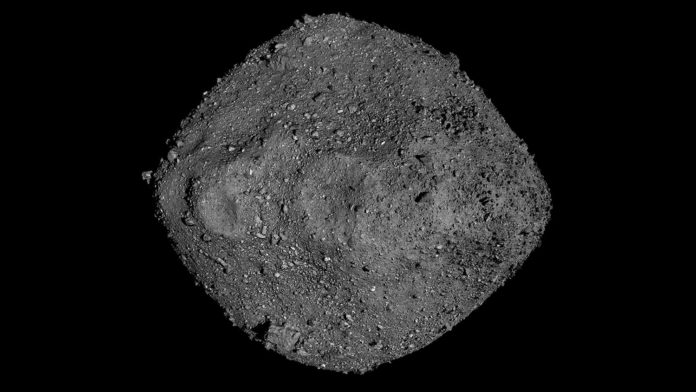Discovered in 1999, near-earth Asteroid Bennu is believed to be a potentially hazardous asteroid. Since its discovery, the Asteroid has been extensively tracked with several ground-based optical astrometric observations.
Now using data from OSIRIS-REx spacecraft, scientists got a better understanding of the movements of this near-earth asteroid through the year 2300. The study, most importantly, reduced uncertainties related to its future orbit. It also improves scientists’ ability to determine the total impact probability and predict orbits of other asteroids.
Kelly Fast, program manager for the Near-Earth Object Observations Program at NASA Headquarters in Washington, said, “NASA‘s Planetary Defense mission is to find and monitor asteroids and comets that can come near Earth and may pose a hazard to our planet. We carry out this endeavor through continuing astronomical surveys that collect data to discover previously unknown objects and refine our orbital models for them. The OSIRIS-REx mission has provided an extraordinary opportunity to refine and test these models, helping us better predict where Bennu will be when it makes its close approach to Earth more than a century from now.”
The Asteroid will make a close approach to Earth in 2135. However, it won’t be dangerous at that time. During the approach, scientists need to understand Bennu’s exact trajectory. This helps them foresee how Earth’s gravity will alter the Asteroid’s path around the Sun – and affect the hazard of Earth impact.
Now, in a new study, scientists used NASA’s Deep Space Network and advanced computer models to shrink uncertainties in Bennu’s orbit. They determined its total impact probability through the year 2300. They found only a slight chance of asteroid Bennu hitting Earth- about 1 in 1,750 (or 0.057%).
Scientists also identified the single date of potential impact- Sept. 24, 2182, with an impact probability of 1 in 2,700 (or about 0.037%).
Study lead Davide Farnocchia of the Center for Near-Earth Object Studies (CNEOS) said, “The OSIRIS-REx data give us so much more precise information, we can test the limits of our models and calculate the future trajectory of Bennu to a very high degree of certainty through 2135. We’ve never modeled an asteroid’s trajectory to this precision before.”
To estimate where the Asteroid will be during its 2135 close approach and whether it might pass through a gravitational keyhole, scientists evaluated several types of small forces that may affect the Asteroid. They found that even the tiny force can significantly deflect its orbital path over time. This may lead the Asteroid to pass through or completely miss a keyhole.
Scientists considered several forces, including the gravity of the Sun, the planets, their moons, and more than 300 other asteroids, the drag caused by interplanetary dust, the pressure of the solar wind, and Bennu’s particle-ejection events. They then evaluated the force OSIRIS-REx exerted when performing its Touch-And-Go (TAG) sample collection event on Oct. 20, 2020, to see if it might have slightly altered Bennu’s orbit. Their evaluations confirm previous estimates that the TAG event had a negligible effect.
Rich Burns, OSIRIS-REx project manager at NASA’s Goddard Space Flight Center in Greenbelt, Maryland, said, “The force exerted on Bennu’s surface during the TAG event was tiny even in comparison to the effects of other small forces considered. TAG did not alter Bennu’s likelihood of impacting Earth.”
Journal Reference:
- Davide Farnocchia, Steven R. Chesley et al. Ephemeris and hazard assessment for near-Earth Asteroid (101955) Bennu based on OSIRIS-REx data. DOI: 10.1016/j.icarus.2021.114594
